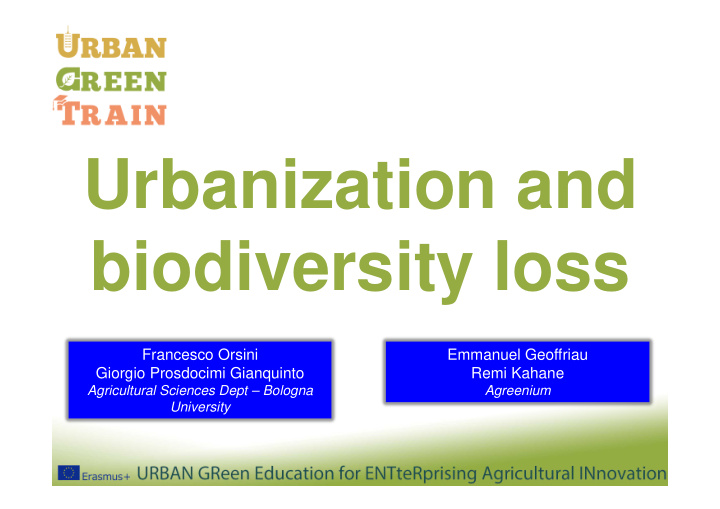



Urbanization and biodiversity loss Francesco Orsini Emmanuel Geoffriau Giorgio Prosdocimi Gianquinto Remi Kahane Agricultural Sciences Dept – Bologna Agreenium University
Cities and biodiversity Growing urbanization Ecological networking Urbanization and biodiversity
The increasing urbanization 100 Wednesday, 90 23 rd May 80 2007 % on Total Population 70 60 3.303.992.253 50 People were living in the cities 40 30 3.303.866.404 20 People were living in rural areas 10 0 1800 1850 1900 1950 2000 2050 Anno Year (Source: ScienceDaily, http://www.sciencedaily.com/releases/2007/05/070525000642.htm )
The increasing urbanization Urban Population (%) Latin Year North World Africa Asia Europe America Oceania America & Caribe 2010 50.6 39.9 42.5 72.6 79.4 82.1 70.6 2030 59.7 50.0 54.1 77.8 84.6 86.7 72.6 2050 69.6 61.8 66.2 83.8 88.7 90.2 76.4 In 1950, 83 cities with more than 1 million of inhabitants (metropolis) In 2006, more than 400 metropolis, and 21 megalopolis (inhabitants > 10 millions In 2020, 27 megalopolis: 13 in Asia, 6 in Latin America, 5 through Europe and North America, 3 in Africa (Source: Citymayors, http://www.citymayors.com/statistics/largest-cities-mayors-intro.html )
Biodiversity hotspots and cities growth Secretariat of the Convention on Biological Diversity (2012)
Global biodiversity loss Chapin et al. (2000)
Urban sprawl and biodiversity Loss of agricultural land
Loss of agricultural land Urban expansion on highly productive agricultural field, in Sweden (Photo: K. Nilsson)
Loss of agricultural land in Europe in 2000-2025
Urban sprawl and biodiversity Loss of agricultural land Deforestation, habitat destruction, landscape and ecosystem fragmentation.
Loss of core habitat caused by road construction cutting through a patch of habitat (EEA, 2011)
Example of landscape change from Switzerland: aerial photographs of Arisdorf (canton of Basel-country) from 1953 (left) and 1994 (right). (EEA, 2011)
Biotic homogeneization
Urban biodiversity Botanical garden - Singapore Atlantic forrest – Rio De Janeiro
Urban biodiversity Rua Gonçalo de Carvalho in Porto Alegre, Brazil
Urban sprawl and biodiversity Loss of agricultural land Deforestation, habitat destruction, landscape and ecosystem fragmentation. Reduction of open spaces and greater distance between green areas
Reduction of open spaces
Urban sprawl and biodiversity Loss of agricultural land Deforestation, habitat destruction, landscape and ecosystem fragmentation. Reduction of open spaces and greater distance between green areas Traffic congestion and air pollution
Increase of private car use, traffic congestion and air and water pollution
Greenhouse gas footprint per capita for transport in UK local authorities and urban-rural pattern (EEA, 2010)
Urban sprawl and biodiversity Loss of agricultural land Deforestation, habitat destruction, landscape and ecosystem fragmentation. Reduction of open spaces and greater distance between green areas Traffic congestion and air pollution Soil sealing and increased flood risk
Degree of mean soil sealing per city – share of cities per class per country (EEA, 2012)
Exposure to flood risk under climate change (EEA, 2010)
Urban sprawl and biodiversity Loss of agricultural land Deforestation, habitat destruction, landscape and ecosystem fragmentation. Reduction of open spaces and greater distance between green areas Traffic congestion and air pollution Soil sealing and increased flood risk Urban Heat Island
Urban Heat Island: soil sealing and surface temperatures in Budapest Hungary, (EEA, 2010)
Urban climate analysis map for the city of Arnhem, the Netherlands (EEA, 2012)
Mean soil sealing in Europe’s cities in 2006 and modelled change of number of tropical nights (>20 ° C) during summer between 1961-1990 and 2010-2040 indicating higher risks of heat waves
Cities and biodiversity Biological diversity in wildland, agricultural and urban habitats (Shochat et al., 2010). In Arizona, agricultural land retains spider and bird communities that are as rich as in the sonoron desert, whereas biological richness declines in the urban habitat.
Urban ecosystems Urban ecosystem are artificial and offer specific habitat conditions. Biodiversity in the urban environment is highly specific and varies in relation to human pressure and activities.
Urban ecosystems Urban ecosystem are artificial and offer specific habitat conditions. Biodiversity in the urban environment is highly specific and varies in relation to human pressure and activities.
Urban ecosystems: impact of urban sprawl 2000-2006 in Madrid Natura 2000 sites
Biodiversity and ecosystem services (Millennium Ecosystem Assessment, 2005)
Ecosystem services and well-being
Urban green in EU (EEA, 2012)
Share of green urban areas in EU cities in 2006 (EEA, 2010)
Quality of green areas inside and around cities in 2006 (EEA, 2010)
Urbanization and biodiversity: Bullet Points • World urban population is greater than rural one and expected to grow in coming years; • Cities are growing mainly in world biodiversity hotspots • City growth causes agricultural lands reduction, deforestation and habitat loss, reduction of open spaces, pollution and soil sealing, overall resulting in lower climate resilience and biodiversity loss. •
Recommend
More recommend